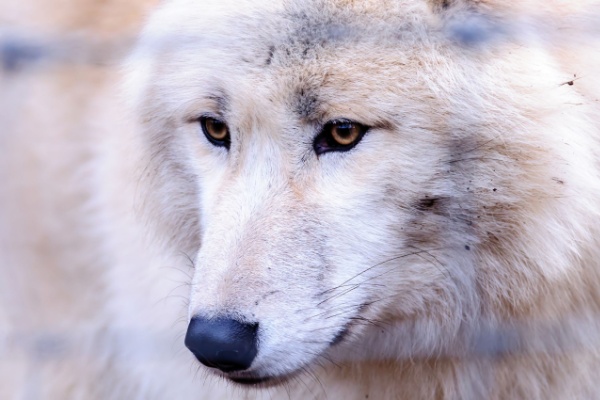 Game of Thrones Fans Rejoice: Dire Wolves Have Been Brought Back to Life
Game of Thrones Fans Rejoice: Dire Wolves Have Been Brought Back to Life
Scientists at a Dallas-based biotech firm recently announced they have brought back the to life the dire wolf, a species popularized by the fantasy TV show “Game of Thrones.”
Colossal Biosciences, the genetic engineering company working to bring back the woolly mammoth, has actually already brought back one of its extinct Ice Age cohabitants: the dire wolf. The Dallas, Texas-based biotech company revealed Monday the recent successful birth of three dire wolf puppies, a major step in proving the viability of Colossal’s “de-extinction technologies” and its potential use in bringing back other species.
As USA Today reports, the birth of the dire wolf pups marks the first successfully de-extincted animal, Colossal CEO and co-founder Ben Lamm said in a press release. “Our team took DNA from a 13,000-year-old tooth and a 72,000-year-old skull and made healthy dire wolf puppies,” Lamm said. “It was once said, ‘any sufficiently advanced technology is indistinguishable from magic.’ Today, our team gets to unveil some of the magic they are working on and its broader impact on conservation.”
Dire Wolf: Myth vs. Reality
It’s likely you’ve heard of a dire wolf if you’re a fan of the HBO hit show “Game of Thrones,” or of George R.R. Martin’s series of fantasy novels. The “dire wolf was the sigil, or mascot, of the House Stark. It was called a “tough old beast” by head of house, Lord Eddard “Ned” Stark. Others may be familiar with the Grateful Dead song, “Dire Wolf.” Dire wolves have also appeared in video games including Final Fantasy and World of Warcraft, tabletop game classic Dungeons & Dragons, and card game Magic the Gathering.
Books and TV shows aside, these real world canine predators roamed the Earth about 13,000 years ago, weighed around 150 pounds and were seen throughout large swaths of the Americas, according to National Geographic. They preyed on horses of the Ice Age as well as sloths.
“Many people view dire wolves as mythical creatures that only exist in a fantasy world, but in reality, they have a rich history of contributing to the American ecosystem,” said the author Martin, who is also an investor and cultural advisor to Colossal, in a statement. “I get the luxury to write about magic, but Ben and Colossal have created magic by bringing these majestic beasts back to our world.
The carnivore was known for its imposing size, specialized “bone-cracking back teeth” and propensity for preying on large herbivores, according to the publication. About 25% larger than modern-day gray wolves, dire wolves had thicker, more muscular legs, more powerful shoulders, a wider head and snout with larger jaws and teeth. The dire wolf stood about 3½ feet tall and could be even longer than 6 feet and weigh up to 150 pounds.
Romulus, Remus, and Khalessi
Colossal said its latest development is the births of 80-pound brothers Remus and Romulus, and a younger female, Khalessi, named for the popular “Game of Thrones” character.
The dire wolves live in a fenced-in nature preserve in a “secret” location in the U.S., according to a report by Bloomberg, and eat a mix of beef, deer and horse meat, along with specially formulated kibble. They estimate the brothers will weigh about 140 pounds when fully grown and are about 20 to 25% bigger than the gray would be at their age.
“Their coat is just absolutely amazing. It’s super thick,” said Lamm, describing the wolves, which live on a 2,000-acre ecological preserve in the northern U.S. “They are super friendly because we’ve raised them … (chief animal officer) Matt (James) bottle fed them when they were just young pups. But they are starting to come into their own, where they’re acting more and more like wolves.”
Other Extinct Creatures Slated for Resurrection
Lamm and George Church, a biologist at Harvard Medical School, founded Colossal in 2021 with the goal of bringing back the woolly mammoth. Since then, the private company, valued at about $10 billion, according to Bloomberg, has expanded its plans to include the de-extinction of the Australian thylacine (Tasmanian tiger) and the dodo.
Last month, Colossal revealed it had genetically engineered the Woolly Mouse, which shared some coat characteristics with a woolly mammoth, including longer, lighter-colored hair with a rough, woolly texture. “This is a very, very big step for us because it proves that all of the work we’ve been doing for the last three years on the woolly mammoth is exactly what we predicted,” Lamm said at the time.
With the reveal of the dire wolf puppies, Colossal shows “that our end-to-end (de-extinction) toolkit that we talked about with the mouse works, but now it’s working with ancient DNA and it’s been pretty incredible.”
Why Bring Back the Dire Wolf?
Wolves became a focus at Colossal after Lamm and James had a meeting with The MHA (Mandan, Hidatsa and Arikara) Nation in central North Dakota. While talking with the tribal leaders about research on buffalo and bison conservation, “they told us there’s not enough going into wolf conservation,” Lamm said, and began discussing the dire wolf and wolves’ importance to generations of Native Americans.
Soon after that, they met with officials in North Carolina about the state’s Red Wolf Recovery Program, which seeks to increase the population of the one-time extinct animal through breeding in captivity and releasing wolves. At about the same time, investors including Peter Jackson and Tom Brady came on board who were “super excited about this business,” Lamm said.
With the dire wolf, Colossal thought “we could do something that could bring awareness from pop culture to science … and we could build technologies to help wolves, which we did in this process, and do something that the indigenous people were really excited about,” Lamm said. “We kind of joke that we didn’t pursue the dire wolf, in a weird way it pursued us.”
Colossal plans to breed more dire wolves and study them and how they act in packs. As of now, there’s no plan for the wolves to breed. They hope North Carolina is interested in using the company’s technology to bring more Red Wolves into nature, too. Wolves are “critical to ecosystems, they’re helpful to the planet and they’re also an American icon,” Lamm said.
The dire wolf is a symbol that “carries the echoes of our ancestors, their wisdom, and their connection to the wild,” said MHA Nation Tribal Chairman Mark Fox in a statement. “Its presence would remind us of our responsibility as stewards of the Earth – to protect not just the wolf, but the delicate balance of life itself.”
Taking Ethics into Account
Colossal will soon publish a paper about the ancient DNA used to create the three dire wolves. And the company has kept experts in the field informed about their advances.
“I think for me the most exciting thing about this project is that shows how we can use cutting edge technologies in molecular biology to help protect and preserve populations of animals that are at risk of extinction today,” said Elinor Karlsson, the director of vertebrate genomics at the Broad Institute of Harvard and MIT and a geneticist who’s a member of Colossal’s advisory board.
“Colossal produced healthy puppies with genetic variants that haven’t existed for over 10,000 years,” she told USA Today. “To do this, they innovated new methods for sampling, biobanking and cloning. Their work could will help us preserve genetic diversity that is on the brink of disappearing from earth today, which includes a number of Canidae species,” which includes domestic dogs, foxes, wolves and other mammals.” She continued, “I also appreciate how careful Colossal was in the way they approached this work. They prioritized the health and well-being of both the dog mothers and the wolf puppies.”
Colossal constantly weighs the ethics of its technology in case readers are worried about something as happened in the movie “Jurassic Park” coming to fruition. “We have spent a lot of time thinking about whether we should (bring back a species),” Shapiro said. “We weren’t just focused on whether we could. We’ve now proven we can.”
The ability to revive and sustain species is important, she said. “We have to keep in mind and understand that there is an incredible risk in the decision not to use these technologies,” Shapiro said. “We know what the consequences of that decision are and it’s an increased rate of extinction throughout the world.”
—
Photo Credit: Lukiyanov_I / Shutterstock.com


